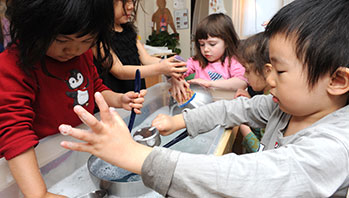- funnels
- newspapers or towels
- pipettes or eyedroppers
- plastic cups
- plastic floor covering
- plastic smocks
- soda bottles
- sponges
- squirt bottles
- three large tubs or water tables
- water
- funnel
- pour
- squirt
MA Standards:
Language/L.PK.MA.6: Use words and phrases acquired through conversations, listening to books read aloud, activities, and play.
MA Draft STE Standards:
Earth and Space Sciences/Earth’s Systems/ESS2.A: Observe, investigate, and classify the non-living materials, natural and human made, in their environment.
Head Start Outcomes:
Logic and Reasoning/Reasoning and Problem Solving: Classifies, compares, and contrasts objects, events, and experiences.
Science Knowledge/Conceptual Knowledge of Natural and Physical Worlds: Observes, describes, and discusses properties of materials and transformation of substances.
PreK Learning Guidelines:
English Language Arts/Language 2: Participate actively in discussions, listen to the ideas of others, and ask and answer relevant questions.
Science and Technology/Earth and Space Sciences 5: Compare and contrast natural materials such as water, rocks, soil, and living organisms using descriptive language.
Science and Technology/Physical Sciences 19: Explore, describe, and compare the properties of liquids and solids found in children's daily environment.
Explore Together (indoors): Pour & Squirt

© Commonwealth of Massachusetts, Department of Early Education and Care (Jennifer Waddell photographer). All rights reserved.
STEM Key Concepts: You can use different objects to move water
ELA Focus Skills: Listening and Speaking, Vocabulary
Educator Prep: For this activity, set up three areas of the room for children to explore.
- Cover the floor with plastic. Put newspapers or towels on top.
- Place three water tables or tubs of water in different areas of your room.
- Place funnels by one tub or water table; place plastic cups, bottles and other containers by another tub or water table.
- Provide water smocks (garbage bags with holes for head and arms work well).
Safety Tips:
- Be sure to clean and disinfect the water table and the plastic containers daily and fill the table with fresh water each day.
- Be sure to have plenty of towels and/or a mop handy for clean-up of spills.
Tell children they are going to explore moving water with different materials. Divide children into three groups.
Invite the first group to sit by the water container and explore moving the water with their hands. As children explore, listen and engage them with questions such as,
- How do you think the water will move if you pound it with your fist?
- What do you think will happen if you flick your fingers instead of wiggling them? Do you think the water will move differently or in the same way? Why do you think that? (You may need to demonstrate the motions out of the water if children are not familiar with words such as pound, flick, or wiggle.)
Invite the second group of children to the water container and give them small plastic cups and bottles or other containers. As children explore, listen and engage them with questions such as,
- How do you think you can move the water with one cup? Two cups?
- Wilbur, show us what you can do with the water and one bottle.
Ask the third group of children to show you ways to use the funnels to move water. Ask questions such as,
- How is moving water in a funnel different from moving water in the cup?
- What happens when you try to carry the water in the funnel?
Give children time to rotate and have a chance at each water station.
Reflect and Share
Gather children together in a circle to share what they discovered. Ask each child to share how they moved water using the materials or their hands. Ask questions such as,
- How did you make the water stay in the funnel when you moved it from the bottle to the pan?
- What did you notice when you tried to move the water by holding it in your hand? Was it easier or more difficult to move the water when you made a little cup with your hand? Why do you think so?
Educator Tip: The three activities can take place at the same time in different parts of your room. Since they explore different aspects of water, each one might appeal to a different group of children. Limit the number of children at each water station. Children will want to try all stations, so be sure to allot enough time for children to circulate through all three areas.
Adaptation: If the weather is warm, wheel your water tables outside or fill a plastic pool with water. Then help children do the activities outdoors, where they can explore without worrying about spills.
